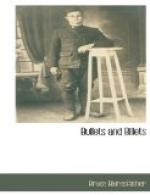On we went down the road through the wood, stumbling along in the darkness over the shell-pitted track. Weird noises occasionally floated through the trees; the faint “crack” of a rifle, or the rumble of limber wheels. A distant light flickered momentarily in the air, cutting out in bold relief the ruins of the shattered chateau on our left. On we went through this scene of dark and humid desolation, past the occasional mounds of former habitations, on into the trenches before Plugstreet Wood.
CHAPTER III
Those Plugstreet trenches—mud
and
rain—flooded out—A
hopeless dawn
An extraordinary sensation—the first time of going into trenches. The first idea that struck me about them was their haphazard design. There was, no doubt, some very excellent reason for someone or other making those trenches as they were; but they really did strike me as curious when I first saw them.
A trench will, perhaps, run diagonally across a field, will then go along a hedge at right angles, suddenly give it up and start again fifty yards to the left, in such a position that it is bound to cross the kitchen-garden of a shattered chateau, go through the greenhouse and out into the road. On getting there it henceforth rivals the ditch at the side in the amount of water it can run off into a row of dug-outs in the next field. There is, apparently, no necessity for a trench to be in any way parallel to the line of your enemy; as long as he can’t shoot you from immediately behind, that’s all you ask.
It was a long and weary night, that first one of mine in the trenches. Everything was strange, and wet and horrid. First of all I had to go and fix up my machine guns at various points, and find places for the gunners to sleep in. This was no easy matter, as many of the dug-outs had fallen in and floated off down stream.
In this, and subsequent descriptions of the trenches, I may lay myself open to the charge of exaggeration. But it must be remembered that I am describing trench life in the early days of 1914, and I feel sure that those who had experience of them will acquit me of any such charge.
To give a recipe for getting a rough idea, in case you want to, I recommend the following procedure. Select a flat ten-acre ploughed field, so sited that all the surface water of the surrounding country drains into it. Now cut a zig-zag slot about four feet deep and three feet wide diagonally across, dam off as much water as you can so as to leave about a hundred yards of squelchy mud; delve out a hole at one side of the slot, then endeavour to live there for a month on bully beef and damp biscuits, whilst a friend has instructions to fire at you with his Winchester every time you put your head above the surface.
Well, here I was, anyway, and the next thing was to make the best of it. As I have before said, these were the days of the earliest trenches in this war: days when we had none of those desirable “props,” such as corrugated iron, floorboards, and sand bags ad lib.




